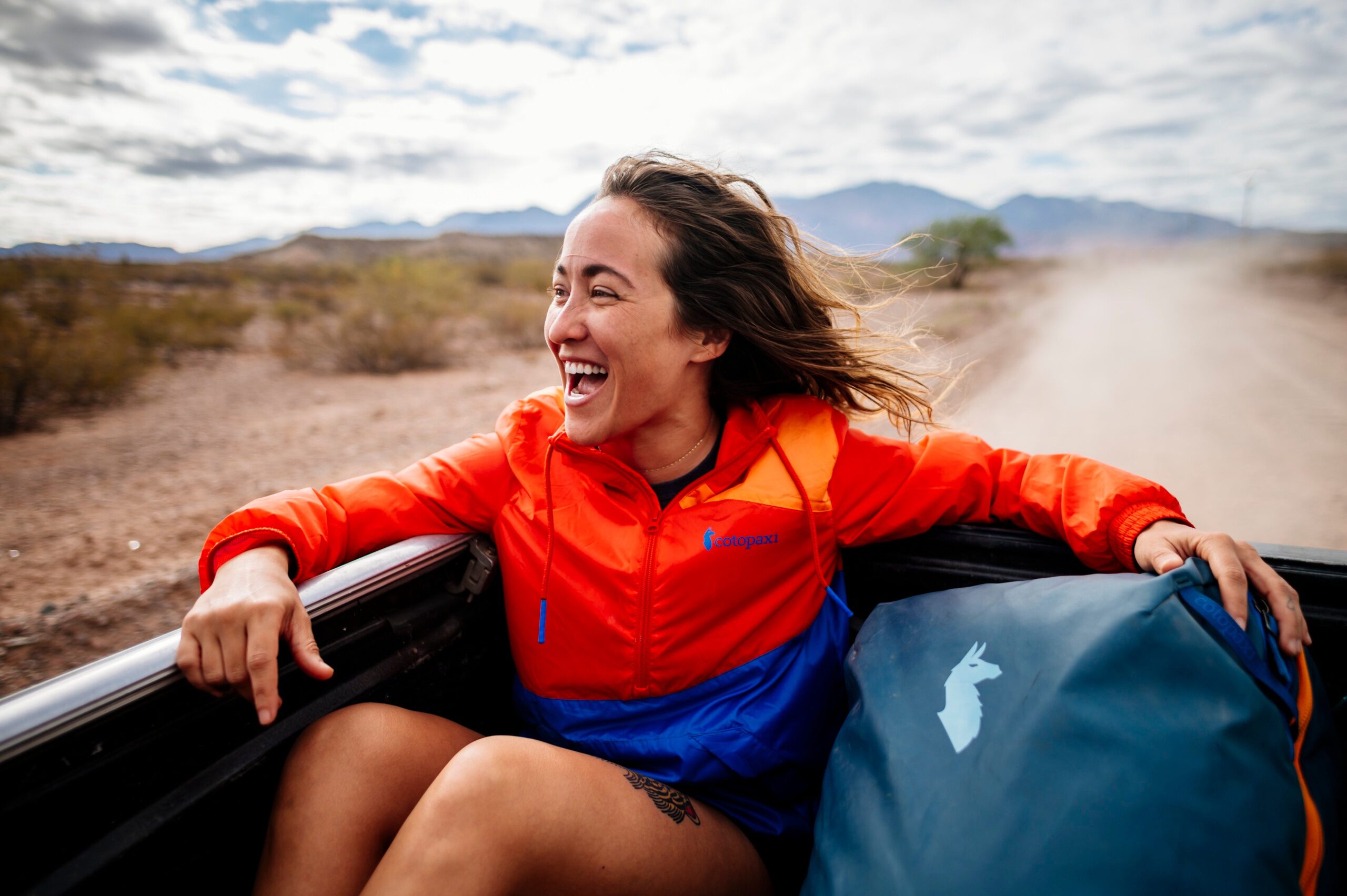Davis Smith, CEO of Cotopaxi, says he’s a little embarrassed that he didn’t start thinking about women’s rights until he became a father to two girls. Smith grew up in Latin America; it shaped his perspective on poverty and drove him to create a brand centered around giving back in 2014. But fatherhood made him really start thinking about gender equity.
“I was a young father and I saw my girls treated differently than boys, and it was infuriating, because I want my girls to have the same opportunities as boys,” he said.
So he joined the board of the Women’s Leadership Institute and Girl Up and became a proud feminist that often quotes from Melinda Gates and First Lady of Canada Sophie Trudeau. He encourages his employees to be active in women’s rights advocacy like when he gave his female employees paid time off to join the ‘Day Without a Woman’ strike on International Women’s Day in 2017.
Today, ��dzٴDZ貹�澱’s product team is comprised of more women than men. Since its inception, 67 percent of the compay’s board has been comprised of women, and at the manager, director, and vice president level the number has been steady at 50 percent. Plus, half of the top earners in the company are women.

Smith says that Cotopaxi grew 15 percent year over year during Q2 of 2020, and in Q3, they grew 97 percent. This was despite giving away nearly $1 million last year when many outdoor brands were flat or slightly negative due to the unforeseen impact of the pandemic. Smith attributes the growth to two things—a business model focused on doing good and the significant number of women in his company.
“There are studies, documented fact, that say when you have women in leadership and more diverse teams, businesses perform better,” said Smith. “What you read in these studies about women and diversity having an impact, we’re seeing the results of that.”
Gender Balance: If You Build It, They Will Come
The question is – how did Cotopaxi achieve gender balance when so many other outdoor brands have not? While Cotopaxi has been involved in initiatives like ElevateHER, which seeks to elevate women’s leadership, Smith says that for Cotopaxi, gender balance was baked into the plan from the beginning..
In his previous business selling baby products in Brazil, two-thirds of the employees—from top to bottom—were women. This created a culture where things that were important to women, like family, were put to the forefront. This experience shaped his vision for Cotopaxi.
When he got a team together to discuss the concept of Cotopaxi, Smith showed a video produced by a competitor.
“It was this white guy jumping out of a helicopter skiing down a mountain with an avalanche chasing behind him. I said ,‘This is exactly who we are not,’” he explained. “We don’t win by creating the most technical product and trying to prove that we’re better than everyone else’s product. We win by creating a more inclusive outdoor brand. When you do that, women will want to join your team.”
Smith pitched his business model, which focused on giving back, to 100 different investors in Silicon Valley in 2013, and the only venture capitalists that were interested were women. Four women investors backed the company when no one else would.
“You could say that was by chance, but I don’t think it was. In my opinion, women understand what the future of capitalism needs to look like better than men. Women understand this idea of using business to be a force for good in the world,” Smith explained.
Smith says that women in the industry took notice that the board and investors were mostly comprised of women, and they sought out positions at Cotopaxi because they believed their voice would be appreciated. It’s resulted in something that Smith says is rare in the outdoor apparel industry—a brand that skews slights towards female customers.
“It’s because we had women who understood the female consumer better than a lot of these other outdoor brands,” he said.
So how do companies in the outdoor industry do what Cotopaxi has done in terms of gender balance? Smith said it is not as simple “as saying, ‘We’re going to have a bunch of women on our board.’” Rather, he said, “You have to create a place where women want to be. First create a brand that women want to be a part of.”
Women and Ownership
Missy Park, CEO of Title Nine, knows a thing or two about creating a brand that women want to join.
While working for Fisher Mountain Bike (now Gary Fisher Bikes) and The North Face in her 20s, she became frustrated that the brands didn’t see or serve the customers that she saw.

“We get change by being the change we seek. That means women stepping up and into those risk-taking ownership positions,” she said.
Park decided to take that risk over 30 years ago when she launched Title Nine in 1989. Even though she says she was naïve and confident in a way that only someone in their mid-20s can be, she was inspired by the sense of community in the outdoor industry and wanted to create a brand that served women, who were at the time, not being served.
Things have changed since Park started her company. Female representation has improved considerably but Park says we aren’t close to being gender balanced.
“I would say the challenge that most women see in the outdoor industry is that most outdoor companies are not run by women, owned by women, or even have a majority of women in decision-making positions,” Park explained.
Park has taken intentional steps to do something about the gender ownership imbalance through things like T9 Pitchfest Outdoor Edition, an annual event that invites women entrepreneurs to pitch their outdoor product. Winners receive mentorship, brand visibility, and marketing and sales assistance from Title Nine. The result is now an expanding number of women outdoor entrepreneurs.
“I think for us the end game is to get more women, leading, risking, and owning. Owning might be the most important part,” said Park. “[While] we want to see women-led companies, we really want to encourage women to hold onto the equity. When I talk about equity, I’m talking about ownership, not equity as equality. Who owns stuff matters.”
The Argument for Gender Balance
Studies show that a gender-balanced company will be more innovative and ultimately more successful. When women see companies with equal representation in leadership positions it inspires more women to be a part of the outdoors. And gender balance will create an industry that accurately reflects our diverse world. According to the two CEOs, it may also be the answer to big challenges the world faces, like poverty and climate change.
“If you really want to save humanity, you have to start by empowering women because women are the ones that change the world,” said Smith. “Why do we invest in women? Because this is the group of people that invest constantly in other people. Studies show that if you want to impact a family, you give money to a mother, and she will invest that money in the things that matter for her children and family. Sadly, that doesn’t happen when men are controlling finances.”
Park brings up a similarly important and popular topic in the outdoor industry—climate change and sustainability. She says that when she speaks with some outdoor industry professionals, they feel pulled between championing different social issues like women’s equality or saving the planet, rather than realize that they’re all interconnected.
“If 50 percent of all leadership positions are held by women, [issues surrounding] sustainability will be solved. Period. End of story. You don’t need to look any further than New Mexico to see what happened when they returned a legislature that’s majority women.”
She’s referring to how the state’s female majority legislature introduced nine bills that focus on stricter air pollution policies, clean water initiatives, renewable energy, and an environmental issues database, as well as a constitutional amendment to protect natural resources and give all residents environmental rights.
“I see the way women lead, how we do it differently, and how the world is going to be a better place because of it. It’s going to be a better place when we all have equal voices,” Park said.
The Role of ‘Generation Next’ and Male Allyship
Both Smith and Park believe that the outdoor industry has made a lot of headway in gender balance, but not nearly enough.
Park looks to what she calls “Generation Next”—millennials and Gen Z—for creative ideas on how to fight social issues like gender balance. “That’s who I do most of my learning from,” she said. That said, she points out that it’s not only up to Generation Next to do the hard work. Women and men in all levels must realize the importance of gender balance and work together to make it happen.
“I always say to change the world, we need women and a lot of understanding male allies,” said Park.
Smith, a self-identified feminist, is one such ally who understands the lasting impact that empowering women can have on the industry and our world.
And he said, “Ultimately, empowering women is not about just women. We empower women and it elevates, everyone. It elevates men. It elevates entire communities.”


